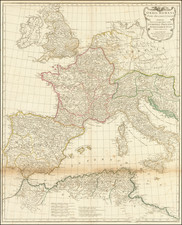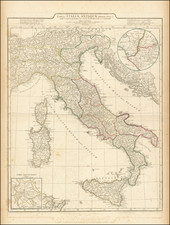Nice example of the Mediterranean chart from Thomson's New General Atlas.
This 1817 Chart of the Mediterranean Sea is a meticulously detailed map focusing on the coastlines and major coastal cities of the Mediterranean basin, reminiscent of early Discovery Era portolan charts. The map emphasizes navigational details, making it an essential tool for mariners of the time.
The central chart presents a comprehensive view of the Mediterranean region, spanning from the Iberian Peninsula to the Levant, and from North Africa to the southern shores of Europe. The primary map is distinguished by its precision in depicting coastal contours, islands, and major port cities, crucial for navigation. The surrounding regions are carefully delineated, with particular attention to political boundaries and topographical features, reflecting the geopolitical landscape of the early 19th century.
Enhancing the utility of the chart are seven inset maps, each providing detailed representations of significant harbors: Marseilles, Genoa, Gibraltar, Leghorn (Livorno), Algeziras (Algeciras), Algiers, and Smyrna (Izmir). These insets feature intricate topography and depth soundings, offering valuable information on harbor layouts, anchorages, and navigational hazards.
Created during an era of expanding maritime trade and colonial ambitions, the chart reflects the heightened interest in safe and efficient navigation through the Mediterranean, a vital artery of commerce connecting Europe, Asia, and Africa. Furthermore, the map's production in 1817 places it in the post-Napoleonic era, a time when European powers were re-establishing trade routes and asserting their influence in the Mediterranean.
John Thomson (1777-ca. 1840) was a commercial map publisher active in Edinburgh. He specialized in guide books and atlases and is primarily known for his Atlas of Scotland (1832) and the New General Atlas, first published in 1817 and reissued for the next quarter century. The New General Atlas was a commercial success—it was also published in Dublin and London—and it compiled existing geographic knowledge in compelling ways for a wide audience.
His Atlas of Scotland introduced new geographic information and was the first large-scale atlas of Scotland to be organized by county. It provided the most-accurate view of Scotland available before the Clearances. Work on the atlas began in 1820 and led to Thomson’s bankruptcy in 1830 due to the high costs of gathering the latest surveys and reviewing the required materials. Despite the publication of the atlas, Thomson declared bankruptcy again in 1835.









![(Czech Edition) Tabule zemj, fragin a mest/w nichz G. Paivael fazal [Bunting's Map of the Eastern Mediterranean Region]](https://storage.googleapis.com/raremaps/img/small/93467.jpg)

![[Hand-Drawn Map Showing the Extent of the Ottoman Empire]](https://storage.googleapis.com/raremaps/img/small/99654.jpg)


![(Heightened with Gold]. Paskaerte Van't Oostelyckste Der Middelandsche Zee Gesneden, Gedruckt, en Uytgegeven](https://storage.googleapis.com/raremaps/img/small/83733.jpg)